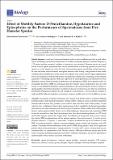Por favor, use este identificador para citar o enlazar a este item:
http://hdl.handle.net/10261/270781COMPARTIR / EXPORTAR:
 SHARE SHARE
 CORE
BASE CORE
BASE
|
|
| Visualizar otros formatos: MARC | Dublin Core | RDF | ORE | MODS | METS | DIDL | DATACITE | |

| Título: | Effect of Motility Factors D-Penicillamine, Hypotaurine and Epinephrine on the Performance of Spermatozoa from Five Hamster Species |
Autor: | Tourmente, Maximiliano CSIC ORCID; Sánchez-Rodríguez, Ana CSIC ORCID CVN; Roldán, Eduardo R. S. CSIC ORCID | Palabras clave: | Sperm performance Hamster Sperm motility Acrosome integrity ATP content Mesocricetus auratus Cricetulus griseus Phodopus sungorus Phodopus roborovskii Phodopus campbelli |
Fecha de publicación: | 30-mar-2022 | Editor: | Multidisciplinary Digital Publishing Institute | Citación: | Biology 11(4): 526 (2022) | Resumen: | Assessments of sperm performance are valuable tools for the analysis of sperm fertilizing potential and to understand determinants of male fertility. Hamster species constitute important animal models because they produce sperm cells in high quantities and of high quality. Sexual selection over evolutionary time in these species seems to have resulted in the largest mammalian spermatozoa, and high swimming and bioenergetic performances. Earlier studies showed that golden hamster sperm requires motility factors such as D-penicillamine, hypotaurine and epinephrine (PHE) to sustain survival over time, but it is unknown how they affect swimming kinetics or ATP levels and if other hamster species also require them. The objective of the present study was to examine the effect of PHE on spermatozoa of five hamster species (Mesocricetus auratus, Cricetulus griseus, Phodopus campbelli, P. sungorus, P. roborovskii). In sperm incubated for up to 4 h without or with PHE, we assessed motility, viability, acrosome integrity, sperm velocity and trajectory, and ATP content. The results showed differences in the effect of PHE among species. They had a significant positive effect on the maintenance of sperm quality in M. auratus and C. griseus, whereas there was no consistent effect on spermatozoa of the Phodopus species. Differences between species may be the result of varying underlying regulatory mechanisms of sperm performance and may be important to understand how they relate to successful fertilization. | URI: | http://hdl.handle.net/10261/270781 | DOI: | 10.3390/biology11040526 | ISSN: | 2079-7737 |
| Aparece en las colecciones: | (MNCN) Artículos |
Ficheros en este ítem:
| Fichero | Descripción | Tamaño | Formato | |
|---|---|---|---|---|
| Roldán_Effect.pdf | Artículo principal | 1,52 MB | Adobe PDF |  Visualizar/Abrir |
CORE Recommender
SCOPUSTM
Citations
3
checked on 20-abr-2024
WEB OF SCIENCETM
Citations
3
checked on 26-feb-2024
Page view(s)
31
checked on 26-abr-2024
Download(s)
53
checked on 26-abr-2024
Google ScholarTM
Check
Altmetric
Altmetric
Este item está licenciado bajo una Licencia Creative Commons

